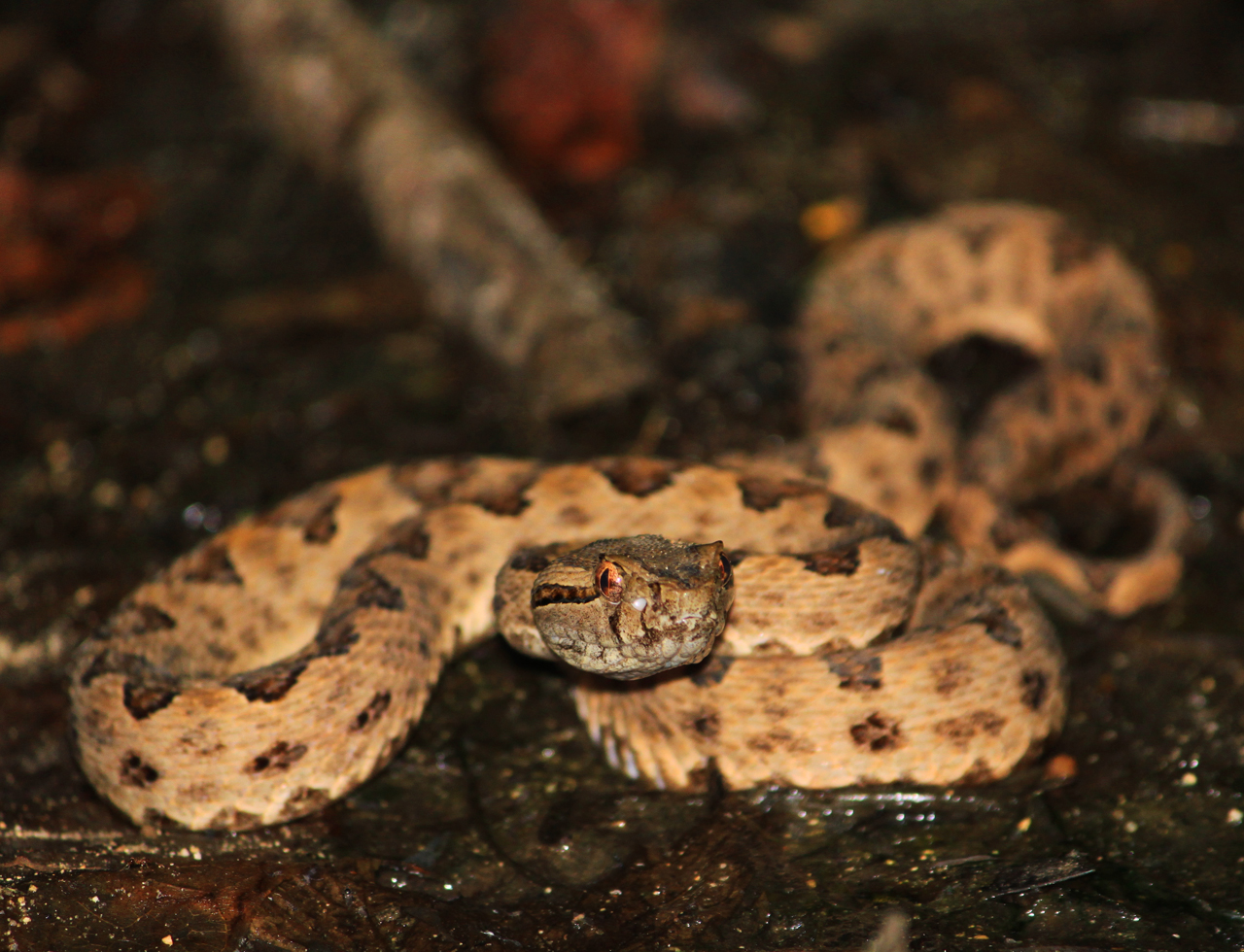|
Trimeresurus Elegans
''Protobothrops elegans'' is a pit viper species endemic to Japan in the southern Ryukyu Islands. No subspecies are currently recognized. Common names include: elegant pit viper,Gumprecht A, Tillack F, Orlov NL, Captain A, Ryabov S. 2004. ''Asian Pitvipers''. GeitjeBooks. Berlin. 1st Edition. 368 pp. . ,Mehrtens JM. 1987. ''Living Snakes of the World in Color''. New York: Sterling Publishers. 480 pp. . and elegant tree viper.Brown JH. 1973. ''Toxicology and Pharmacology of Venoms from Poisonous Snakes''. Springfield, Illinois: Charles C. Thomas. 184 pp. LCCCN 73-229. . Description Scalation includes 25 (sometimes 23) rows of dorsal scales at midbody, 179–192 (males) or 182–196 (females) ventral scales, 63–90 subcaudal scales, and 8 (sometimes 7 or 9) supralabial scales. During 1965–2011, 2447 snakebites from this snake are reported with one fatality. Geographic range It is found in Japan in the southern Ryukyu Islands, specifically in the Yaeyama Islands. The type loca ... [...More Info...] [...Related Items...] OR: [Wikipedia] [Google] [Baidu] |
John Edward Gray
John Edward Gray (12 February 1800 – 7 March 1875) was a British zoologist. He was the elder brother of zoologist George Robert Gray and son of the pharmacologist and botanist Samuel Frederick Gray (1766–1828). The same is used for a zoological name. Gray was keeper of zoology at the British Museum in London from 1840 until Christmas 1874, before the natural history holdings were split off to the Natural History Museum. He published several catalogues of the museum collections that included comprehensive discussions of animal groups and descriptions of new species. He improved the zoological collections to make them amongst the best in the world. Biography Gray was born in Walsall, but his family soon moved to London, where Gray studied medicine. He assisted his father in writing ''The Natural Arrangement of British Plants'' (1821). After being blackballed by the Linnean Society of London, Gray shifted his interest from botany to zoology. He began his zoological ... [...More Info...] [...Related Items...] OR: [Wikipedia] [Google] [Baidu] |
Dorsal Scales
In snakes, the dorsal scales are the longitudinal series of plates that encircle the body, but do not include the ventral scales. Campbell JA, Lamar WW (2004). ''The Venomous Reptiles of the Western Hemisphere''. Ithaca and London: Comstock Publishing Associates. 2 volumes. 870 pp. 1,500 plates. . When counting dorsal scales, numbers are often given for three points along the body, for example 19:21:17. These numbers correspond to the number of dorsal scales around the body at a head's length behind the head, at midbody and at a head's length before the vent. If only one number is given, it is for the midbody count. Dorsal scale are easiest to count diagonally, starting with the paraventral scale row. In doing so, it is often noted that certain scale rows are raised, keeled or smooth as opposed to the others.U.S. Navy (1991). ''Poisonous Snakes of the World''. United States Government. New York: Dover Publications Inc. 203 pp. . See also *Snake scales *Anatomical terms of locat ... [...More Info...] [...Related Items...] OR: [Wikipedia] [Google] [Baidu] |
Endemic Fauna Of The Ryukyu Islands
Endemism is the state of a species being found only in a single defined geographic location, such as an island, state, nation, country or other defined zone; organisms that are indigenous to a place are not endemic to it if they are also found elsewhere. For example, the Cape sugarbird is found exclusively in southwestern South Africa and is therefore said to be ''endemic'' to that particular part of the world. An endemic species can also be referred to as an ''endemism'' or, in scientific literature, as an ''endemite''. Similarly, many species found in the Western ghats of India are examples of endemism. Endemism is an important concept in conservation biology for measuring biodiversity in a particular place and evaluating the risk of extinction for species. Endemism is also of interest in evolutionary biology, because it provides clues about how changes in the environment cause species to undergo range shifts (potentially expanding their range into a larger area or becomin ... [...More Info...] [...Related Items...] OR: [Wikipedia] [Google] [Baidu] |
Snakes Of Asia
Snakes are elongated limbless reptiles of the suborder Serpentes (). Cladistically squamates, snakes are ectothermic, amniote vertebrates covered in overlapping scales much like other members of the group. Many species of snakes have skulls with several more joints than their lizard ancestors and relatives, enabling them to swallow prey much larger than their heads (cranial kinesis). To accommodate their narrow bodies, snakes' paired organs (such as kidneys) appear one in front of the other instead of side by side, and most only have one functional lung. Some species retain a pelvic girdle with a pair of vestigial claws on either side of the cloaca. Lizards have independently evolved elongate bodies without limbs or with greatly reduced limbs at least twenty-five times via convergent evolution, leading to many lineages of legless lizards. These resemble snakes, but several common groups of legless lizards have eyelids and external ears, which snakes lack, although this rule ... [...More Info...] [...Related Items...] OR: [Wikipedia] [Google] [Baidu] |
Protobothrops
''Protobothrops'' is a genus of pit vipers found in Asia.. The venom of ''Protobothrops'' can be diverse and unique across individual organisms of the same and differing species and has demonstrated the ability to evolve in an accelerated manner. One possible explanation for these traits is that the habitat in which ''Protobothrops'' reside contains a large variety of prey which may have prompted the diversification of the venom related genes. Species ''Nota bene'': A Binomial nomenclature, binomial authority in parentheses indicates that the species was originally described in a genus other than ''Protobothrops''. References Protobothrops, Crotalinae Snake genera Taxa named by Alphonse Richard Hoge Taxa named by Sylvia Alma Renata Wilma de Lemos Romano-Hoge {{Snake-stub ... [...More Info...] [...Related Items...] OR: [Wikipedia] [Google] [Baidu] |
Snakebite
A snakebite is an injury caused by the bite of a snake, especially a venomous snake. A common sign of a bite from a venomous snake is the presence of two puncture wounds from the animal's fangs. Sometimes venom injection from the bite may occur. This may result in redness, swelling, and severe pain at the area, which may take up to an hour to appear. Vomiting, blurred vision, tingling of the limbs, and sweating may result. Most bites are on the hands, arms, or legs. Fear following a bite is common with symptoms of a racing heart and feeling faint. The venom may cause bleeding, kidney failure, a severe allergic reaction, tissue death around the bite, or breathing problems. Bites may result in the loss of a limb or other chronic problems or even death. The outcome depends on the type of snake, the area of the body bitten, the amount of snake venom injected, the general health of the person bitten, and whether or not anti-venom serum has been administered by a doctor ... [...More Info...] [...Related Items...] OR: [Wikipedia] [Google] [Baidu] |
Ishigaki, Okinawa
is a Cities of Japan, city in Okinawa Prefecture, Japan. It includes Ishigaki Island, Ishigaki island and the Senkaku Islands territory. The city is the political, cultural, and economic center of the Yaeyama Islands. New Ishigaki Airport serves the city. As of December 2012, the city has an estimated population of 48,816 and a population density of 213 persons per km2. The total area is 229.00 km2. It is also the location of the Senkaku Islands (see below in the Geography section). History The current city of Ishigaki was founded in 1908 as Yaeyama Village, an amalgamation of the Ishigaki, Ōhama, and Miyara magiri. In 1914 it was renamed to Ishigaki Village, and grew to become Ishigaki Town in 1926. Ishigaki was elevated to city status on July 10, 1947. Historical footnote: One of the first Frenchmen ever to visit Japan, Guillaume Courtet, came ashore at Ishigaki in 1636. Geography The city of Ishigaki covers the entirety of Ishigaki Island (). The island is surrounded ... [...More Info...] [...Related Items...] OR: [Wikipedia] [Google] [Baidu] |
Type Locality (biology)
In biology, a type is a particular wikt:en:specimen, specimen (or in some cases a group of specimens) of an organism to which the scientific name of that organism is formally associated. In other words, a type is an example that serves to anchor or centralizes the defining features of that particular taxon. In older usage (pre-1900 in botany), a type was a taxon rather than a specimen. A taxon is a scientifically named grouping of organisms with other like organisms, a set (mathematics), set that includes some organisms and excludes others, based on a detailed published description (for example a species description) and on the provision of type material, which is usually available to scientists for examination in a major museum research collection, or similar institution. Type specimen According to a precise set of rules laid down in the International Code of Zoological Nomenclature (ICZN) and the ''International Code of Nomenclature for algae, fungi, and plants'' (ICN), the ... [...More Info...] [...Related Items...] OR: [Wikipedia] [Google] [Baidu] |
Yaeyama Islands
The Yaeyama Islands (八重山列島 ''Yaeyama-rettō'', also 八重山諸島 ''Yaeyama-shotō'', Yaeyama: ''Yaima'', Yonaguni: ''Daama'', Okinawan: ''Yeema'', Northern Ryukyuan: ''Yapema'') are an archipelago in the southwest of Okinawa Prefecture, Japan, and cover . The islands are located southwest of the Miyako Islands, part of the Ryukyu Islands archipelago. The Yaeyama Islands are the most remote part of Japan from the main islands and contain Japan's southernmost ( Hateruma) and westernmost (Yonaguni) inhabited islands. The city of Ishigaki serves as the political, cultural, and economic center of the Yaeyama Islands. On maps dating to the 1700s, the Yaeyama Group of Islands appears as the "Majico Sima Group", "Nambu-soto Islands", "Nambu Soto", and the "Taipin Islands". Name The name ''Yaeyama'' literally means "multilayered mountains", and is related to the native name ''Yaima'' in Yaeyama, which possibly comes from a reconstructed Proto-Ryukyuan form ''*jajama'' ... [...More Info...] [...Related Items...] OR: [Wikipedia] [Google] [Baidu] |
Supralabial Scales
In reptiles, the supralabial scales, also called upper-labials, are those scales that border the mouth opening along the upper jaw. They do not include the median scaleWright AH, Wright AA. 1957. Handbook of Snakes. Comstock Publishing Associates (7th printing, 1985). 1105 pp. . (rostral scale). The term '' labial'' originates from (Latin for "lip"), which refers to any lip-like structure. The numbers of these scales present, and sometimes the shapes and sizes, are some of many characteristics used to differentiate species from one another. Related scales * Sublabial scales * Rostral scale * Mental scale See also * Labial scales * Snake scales * Anatomical terms of location Standard anatomical terms of location are used to describe unambiguously the anatomy of humans and other animals. The terms, typically derived from Latin or Greek roots, describe something in its standard anatomical position. This position pr ... References {{Reflist Snake scales ... [...More Info...] [...Related Items...] OR: [Wikipedia] [Google] [Baidu] |
Subcaudal Scales
In snakes, the subcaudal scales are the enlarged plates on the underside of the tail. Wright AH, Wright AA (1957). ''Handbook of Snakes of the United States and Canada''. Comstock Publishing Associates, a Division of Cornell University Press. (7th printing, 1985). 1,105 pp. (in two volumes). . These scales may be either single or divided (paired) and are preceded by the anal scale. Related scales * Anal scale * Ventral scales See also * Snake scales Snakes, like other reptiles, have skin covered in scales.Boulenger, George A. 1890 The Fauna of British India. p. 1 Snakes are entirely covered with scales or scutes of various shapes and sizes, known as snakeskin as a whole. A scale protects ... References {{Reflist Snake scales ... [...More Info...] [...Related Items...] OR: [Wikipedia] [Google] [Baidu] |





